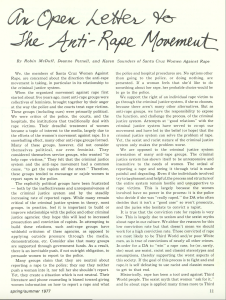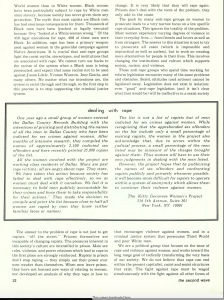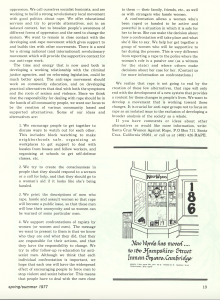This Article titled, “An Open Letter to the Anti-Rape Movement,” by radical and socialist feminists, Robin McDuff, Deanne Pernell, and Karen Saunders, was published as a part of the feminist periodical Second Wave volume 5 no.1 in 1977.This periodical was designed to be an accessible resource, so that all women, regardless of socioeconomic status, could be kept informed about current issues in the political and social spheres. The hope being that this awareness would create a joint consciousness that would educate and help women feel like they could exercise autonomy over their own lives.
This article examines the issues of rape during the second wave of feminism and serves as a critique of the anti-rape movement’s relationship to the justice system. This article exposes the staggering failures and sexist foundation of the criminal justice system in cases of rape and insists that a “strong revolutionary local movement” outside of legislative reform is the only way to abolish rape. During this period many anti-rape groups evolved from labeling themselves as feminist groups, whose goal was dismantling the sexist justice system, to identifying as “service groups” for rape victims who believed they and the justice system had a common purpose to “get rapists off the street”(11). The authors contest this change writing, “attempts at ‘good relations’ with the criminal justice system have seemed to co-opt our movement and have led to the belief (or hope) that the criminal justice system can solve the problem of rape. Yet, the sexist nature of the justice system only makes the problem worse” (11). They continue to say “sexist attitudes (and actions) cannot be legislated away. Legislation does not exist in isolation; even ‘good’ anti-rape legislation (and it isn’t clear what that would be) will be ineffective in a sexist society that encourages violence against women” (12). These women promoted alternative solutions to combat rape that did not include legislative reform or working with the justice system initially. Although the end goal of the anti-rape movement is the creation of effective and beneficial anti-rape legislation and the abolishment of rape, these authors call attention to the fact that criminal justice legislature currently is only amplifying the issues involved in rape and this won’t change until the root causes of rape, like sexism, are dismantled.



“An Open Letter to the Anti-Rape Movement” by Robin McDuff, Deanne Pernell, and Karen Saunders was published in 1977 as a part of the volume 5 no.1 issue of the feminist periodical Second Wave.
This article promotes the idea that attempting to combat rape through the present justice system by encouraging more women to go through the courts ignores the totality of the issue of sexual violence as women experience violence and harassment to a varying degree every day and this will not be prevented by mere legislation (12). They propose that the “answer to the situation is not to try to prosecute all cases (which is impossible and impractical as well as useless) but to work on creating more alternatives for people in their lives” (12). They highlight that even when a rapist is prosecuted the prison systems “are incapable of changing rapists… male sex roles, violence, and power relations which lead to rape in the first place are strongly reinforced (in prison)… prisons don’t deal with the roots of the problem, they only add to the cause” (12). Not to say that rapists should not go to prison, but that all aspects of the criminal justice system require staggering revolutionary reform.
The authors conclude their article by emphasizing again that in order to abolish rape the anti-rape movement should first, “work on community education, and on developing practical alternatives [rather than legislative] that deal with both the symptoms and the root causes of sexism and violence” (13). They offer four practical alternatives to combating rape within the community. First they encourage women to group together and discuss strategies and ways in which they can look out for each other in the community and domestic spheres. Secondly they urge a joint effort in being active bystanders so when people hear someone call for help, or see someone who looks like they are being hassled they are active in responding or getting help. Next they call for the publication of decriptioms and identities of individuals who rape, harass, or assault so those men/women lose anonymity and women can better protect themselves and others. Lastly they state that the community should support the confrontations of victims with their assaulters outside of the justice system if the survivors chose to do so. A confrontation allows the victims to “be active and powerful in a situation in which it is safe for her be so” which is different from reporting a rape “where the woman’s role is a passive one[out of no fault of her own]” due to the unbalanced power structure present in the justice system(13). These are practical solutions that are meant for anyone to be able to implement in their lives with the hope that a community effort will urge the effort toward more permanent reform. This article illustrates the ways women used publications to raise awareness about the uncensored truth of rape in order to educate women and help them become active in combating violence against women in their everyday lives.
Work Cited
Elana Dykewoman, et al. “The Second Wave.” Second Wave, The, vol. 5, no. 1, The Second Wave, Inc., Mar. 1977, pp. 1–60, https://jstor.org/stable/community.28044449.
